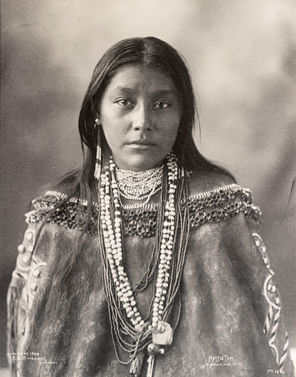Seattle’s Henry Art Gallery poses a photographic puzzle with “Out [o] Fashion Photography: Embracing Beauty,’ a wide-ranging show exploring cultural attitudes about beauty, running through Sept. 1, 2013.
By Michael Upchurch, The Seattle Times

“Hattie Tom, Apache” (1899), platinum print
What is beauty? How do concepts of beauty change? And who possesses beauty — those who observe it or those who are observed?
These are among the questions raised in “Out [o] Fashion Photography: Embracing Beauty,” a new exhibit at the Henry Art Gallery, curated by Deborah Willis, the first scholar to take part in the Henry’s new Visiting Fellow Program.
Willis is a historian of African-American photography who teaches at New York University’s Tisch School of the Arts, where she serves as professor and chair of photography and imaging. A few years ago, the Henry invited her to pore through its holdings and those of the University of Washington Libraries, Special Collections, with the idea of exploring “different attitudes about and cultural interpretations of beauty.”
“Out [o] Fashion Photography” is the result. It’s a big show that weighs how men photograph women, how women photograph men, how photographers turn their lenses on members of the own sex or people of other races, and, finally, how some artists — Cindy Sherman, Robert Mapplethorpe, the amazing Janieta Eyre — translate themselves into the most unlikely photographic icons.
As the exhibit’s punning title suggests, it deals with how ideals of beauty can go out of style, while also acknowledging the role fashion has played in shaping our concept of beauty. Wildly diverse in content, it asks viewers to draw their own connections more than it spells anything out for them.
Willis has divided it into three “thematic groupings,” although she cautions in her catalog essay that “there is overlap throughout, and many images can be discussed in multiple categories.”
If that sounds vague to the point of being unhelpful, it is.
The exhibit is better approached as a free-associative romp through the Henry/UW collections by someone with a curious eye. One question that gets raised again and again, in all three sections, is: Who is exploiting whom in the photographic process?
Willis starts off with works by Edward S. Curtis, whose passion about documenting vanishing Native American cultures may have overridden a more personal connection between the photographer and his subject.
Still, Curtis’ “Two Moons — Cheyenne” (1910) is a fine thing to behold, catching the essence of the war chief’s proud, weathered character. Frank A. Rinehart’s “Hattie Tom, Apache” (1899) tells a different story: The look of skepticism the young woman levels at the camera is withering.
Honest portraiture is one thing. Voyeurism is another.
The voyeuristic norm — of a male eye trained on a female form for purposes of arousal — seems most vividly and straightforwardly represented by E.J. Bellocq’s “Storyville Portrait” (c. 1912). But in other works, things get more complicated.
Don Wallen’s “Untitled” (1976), with its live female nude draped around a plastic-white mannequin, seems to comment on how synthetic some ideals of female beauty can be. Harry Callahan’s gorgeous silhouette shot of his wife, “Eleanor” (1948), uses photographic artifice to create something intimate, loving and mysterious.
Willis includes some actual fashion photography, including items by Hans L. Jorgensen and Irving Penn, where women are idealized by the camera, surely with their own full cooperation. And in shots of famous actresses — Cecil Beaton’s “Marlene Dietrich” (1930) and Benjamin J. Falk’s “Portrait of Miss Rush, the Actress” (c. 1892/1897) — there’s little doubt that the models are shaping their own images as much as the photographer is. “Miss Rush,” in her bow-tie, jacket, vest and trousers, is a dapper gender-bender. Dietrich, here, is in pure glamour-queen mode.
The male figure, if a bit underrepresented, isn’t neglected in “Out [o] Fashion.”
Jack Pierson’s gauzy “Belvedere Clayton” (1992) portrays a dreamy young man, swaddled in a nightshirt, sprawled back in bed and gazing at the camera. There’s something so swooning and heady about his pose that he seems made of gossamer. George Dureau’s black male nude, “Glen Thompson, Rear” (1983), on the other hand, couldn’t be more directly carnal.
In some cases, subjects’ actions, more than their looks, lend a true hypnotic allure to their images. That’s the case with Lewis Wickes Hine’s “Powerhouse Mechanic” (1921) and Barbara Morgan’s “Martha Graham — Letter to the World” (1940), which are slyly juxtaposed in the show.
There’s fine work here that seemingly has nothing to do with Willis’ chosen theme. Weegee’s masterpiece “The Critic” (1943), in which a Bowery character snarls at two preening operagoers, is surely less about beauty than hostilities between two social worlds, while Lisette Model’s “Famous Gambler, Nice” (1934) comes off as a pure character study, with little thought about the attractiveness of its subject (although the photograph itself is certainly handsomely composed).
Diane Arbus’ “A Woman in a Bird Mask, N.Y.C.” (1967) delights in how artifice can triumph over age and take a turn for the beautiful-fantastical. But in Arbus’ “A Family on Their Lawn One Sunday in Westchester, New York” (1968), it’s the total disconnect between husband, wife and child that rivets you far more than the incidental detail of the sunbathing mom’s classic, brittle 1960s looks.
Some of these puzzling inclusions might benefit from more commentary by Willis on individual photographs. Without that, the exhibition is mostly what you choose to make of it.
One thing for sure: There are plenty of photographic riches here — including work by Imogen Cunningham, Dorothea Lange, Edward J. Steichen and many others — to make something from.
![Henry’s ‘Out [o] Fashion’ exhibit takes boundaries off beauty](https://www.tulalipnews.com/wp-content/uploads/2013/04/2020654376-50x50.jpg)